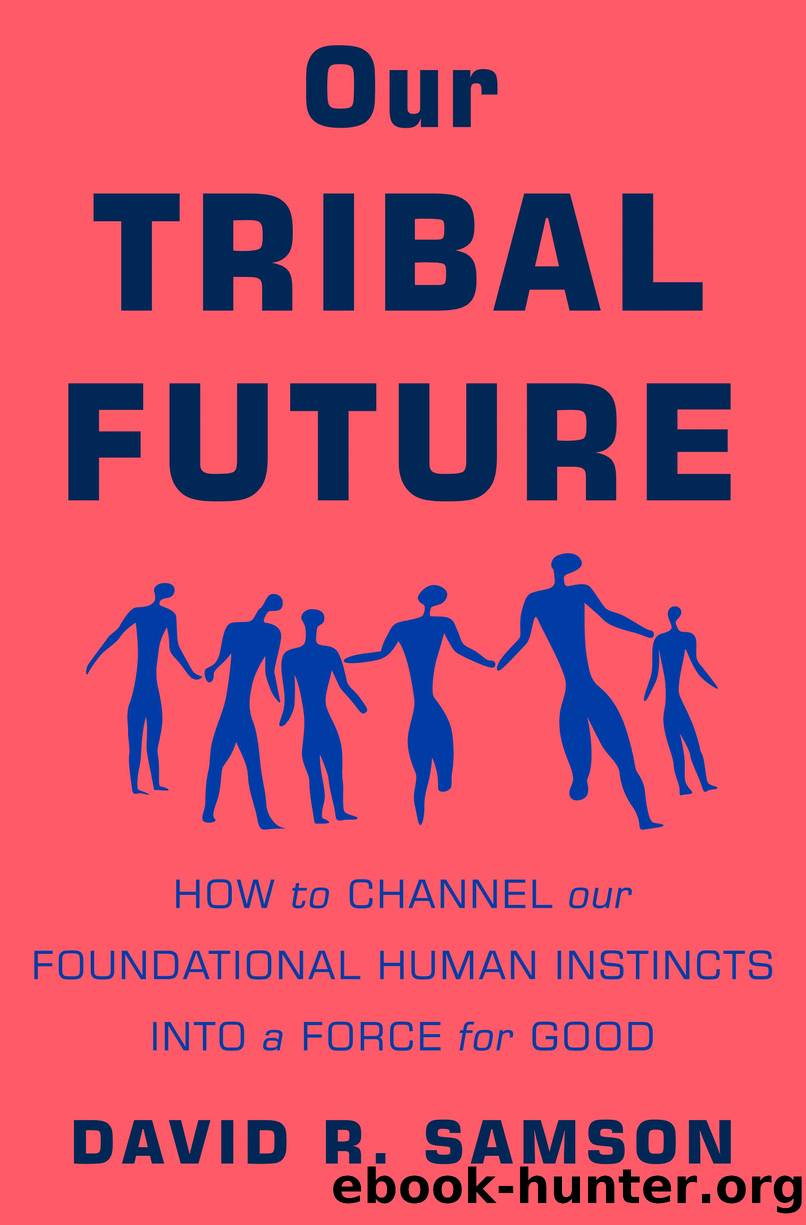Our Tribal Future by David R. Samson

Author:David R. Samson
Language: eng
Format: epub
Publisher: St. Martin's Publishing Group
Identity and PurposeâThe Rocket Fuel of Group Cohesion
Have you ever been part of a group where you felt a pure sense of trust and closeness with its members? A group where you felt you truly belonged? A group with a sense of commitment and purpose so strong you would never even consider leaving? Atkins, Wilson, and Hayes remark: âBeing part of a group with strong bonds of commitment, trust, and shared purpose is deeply, deeply satisfying for human beings.â23 Such occasions, while rare, often stand out as peak human experiences. Fortunately, with applied evolutionary science at our disposal, we can use a tried-and-true formula to create these experiences. Weâve explored some of these highs in chapter eight.
I experienced such highs fighting alongside my medieval martial arts group, The Brotherhood of Steel, at Pennsic; I imagine Randi Griffin also experienced it during her time as an Olympian playing for the Unified Korea hockey team. The commonality among these two groups was that their identities were strongly defined, membership clearly delineated, and purpose crystal clear. And every day the groups worked together more perfectly, cooperating more effectively as they adapted, fought, and negotiated their way through extreme challenges. Although difficult to put a name to this type of feeling, scientists use the term group cohesion. The classic definition from 1950s group performance science defines group cohesion as âthe total field of forces which act on members to remain in a group.â This is the degree to which the group sticks together and is unified in the pursuit of its goals.24
Cohesion can be enhanced with shared identity and purpose. Groups that have this property build a sense of âusâ beyond each individual memberâs self-interest. Groups that donât share a clear sense of purpose and identity are doomed to conflict and splintering; the mechanism driving the wedge is a lack of cohesion. There are two parts to group cohesion: social cohesion and task cohesion. The former answers the question âDo people within the group like, trust, and feel affinity toward one another?â The latter answers the question âDo the people in this group really believe in the goals of the group?â Either believing in group goals but not getting along with its members or vice versa will create substandard group performance. When groups perform well together, they also enhance cohesiveness, and in a virtuous positive feedback loop, enhanced cohesion improves group performance.25 Members of a cohesive group are more likely to work hard and be motivated to perform that work and be loyal.26
Cohesion takes hard work to build. Like trust, it takes much effort to cultivate, and it is easily broken. Yet, when groups have it they become highly motivated to work hard in the name of the group. In fact, studies have shown that cohesion is such an intrinsic value, it is a more important motivator than money.27 One cross-cultural study showed that in war, even more important than physical and material strength is spiritual strength measured as the will to fight, which
Download
This site does not store any files on its server. We only index and link to content provided by other sites. Please contact the content providers to delete copyright contents if any and email us, we'll remove relevant links or contents immediately.
Hit Refresh by Satya Nadella(9040)
The Compound Effect by Darren Hardy(8814)
Change Your Questions, Change Your Life by Marilee Adams(7637)
Nudge - Improving Decisions about Health, Wealth, and Happiness by Thaler Sunstein(7622)
The Black Swan by Nassim Nicholas Taleb(7016)
Deep Work by Cal Newport(6885)
Daring Greatly by Brene Brown(6449)
Rich Dad Poor Dad by Robert T. Kiyosaki(6413)
Principles: Life and Work by Ray Dalio(6220)
Playing to Win_ How Strategy Really Works by A.G. Lafley & Roger L. Martin(5931)
Man-made Catastrophes and Risk Information Concealment by Dmitry Chernov & Didier Sornette(5924)
Digital Minimalism by Cal Newport;(5667)
Big Magic: Creative Living Beyond Fear by Elizabeth Gilbert(5615)
The Myth of the Strong Leader by Archie Brown(5427)
The Slight Edge by Jeff Olson(5352)
Discipline Equals Freedom by Jocko Willink(5286)
The Motivation Myth by Jeff Haden(5157)
Stone's Rules by Roger Stone(5027)
The Laws of Human Nature by Robert Greene(5001)
